Film Breakdown: How Frank Pollack's Wide Zone Scheme Will Impact Joe Mixon and the Bengals' Rushing Attack
The wide zone is arguably the most popular concept used to build an offense for more than three decades. While the wide zone was not created by Mike Shanahan, Gary Kubiak, and Alex Gibbs, it was perfected by them. Those three masterminds created an entire system based around wide zone and with that system, they won multiple Super Bowls.
It led to Terrell Davis running for 2000 yards and then the very next season after Davis was hurt, Olandis Gary ran the same play for nearly 100 yards per game. The next season Mike Anderson had a huge year. Then Clinton Portis ran for 1,500 yards twice. All of these are examples showing how running backs have benefitted from the wide zone system since it was perfected in Denver.
For the past two years, Derrick Henry has been the king of all running backs. He led the league in rushing and even went for 2000 yards last season. He is running in the wide zone system. Before Henry took over, Todd Gurley was the best running back in the league and he was also running in the wide zone system. You could argue before Gurley, it was Ezekiel Elliott. He was also running the wide zone system in Dallas. Who was the offensive line coach in Dallas implementing the wide zone system? None other than current Cincinnati Bengals offensive line coach Frank Pollack.
So what exactly is the wide zone? Why run it? And what can we expect with Pollack’s system?
In the NFL, teams have to choose a run play that they feel confident about running from any formation, any personnel grouping, and into any front. For Pollack, that play is wide zone. So let’s start with a deeper look into what exactly the wide zone is.
It is a zone running play with the running on track for the butt of the tight or “ghost tight end.” While the halfback aims towards the outside, the play is not strictly designed to hit the perimeter, but rather to horizontally displace the defensive front. The running back and the offensive line work together to displace the front with the offensive line working to get to the play side of the defender and the HB pressing the line of scrimmage forcing the defense to work outside.
To go deeper into the definition, we can look at what a zone running play is. Zone runs in general are plays where the offensive line works in unison in one direction to move the defense horizontally and create running lanes. This is different from power or gap running which work to move/displace the defense vertically and push them backward. Zone blocking is better utilized with offensive linemen that can move a little bit because they need to run to the second level and block linebackers. It requires a little bit less power than gap/power running because they are moving the defense horizontally rather than vertically. Typically defenders are more likely to give up ground horizontally than they are vertically. Being pushed backward is a loss, but running with a guy and moving side to side is not necessarily seen as losing in the run game.
Now, let’s go deeper into what the offensive line is doing in wide zone. The play side of the offensive line is trying to get to the play side of the defender. Meaning if the play is wide zone to the left, the left side of the line wants to get their helmet to the left of the defender. This allows the offensive linemen to better control the defensive linemen because the force of the block is going down the middle of the defender. The backside of the offensive line wants to cut off their defender. With the play side pushing the defensive lineman one way and the backside cutting the defensive lineman off, it will create a natural hole in between the two which is one of the most common ways for wide zone to hit.
His wide zone is just a thing of beauty, man. Look at Travis Frederick at C snap and get his hat to the playside shoulder of the shaded NT. Tyron Smith blowing up the front side. The read is clearly defined for the RB. pic.twitter.com/rOUKXiCvg1
— mike (@bengals_sans) August 3, 2021
Here I want to highlight the center Travis Frederick who perfectly displays what I am talking about.
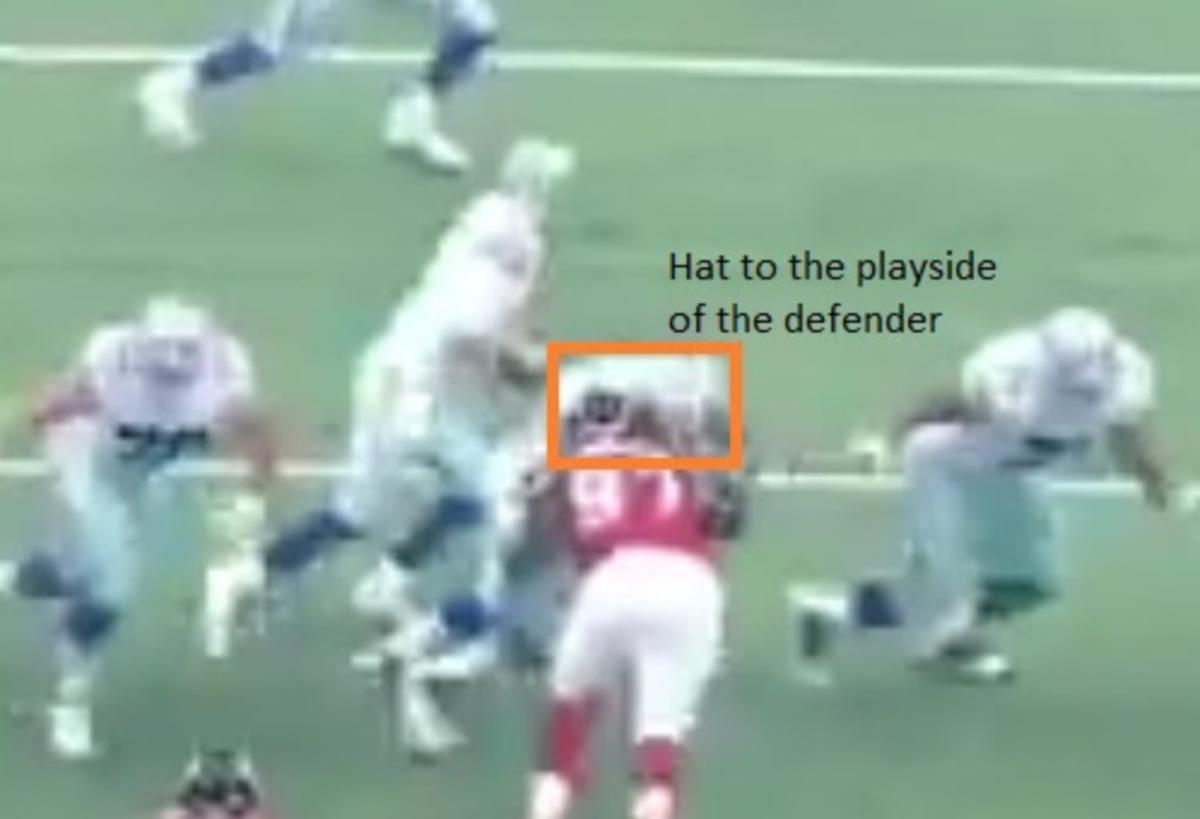
He starts by getting his helmet to the playside of the defender which helps him both move the defender and seal him off.
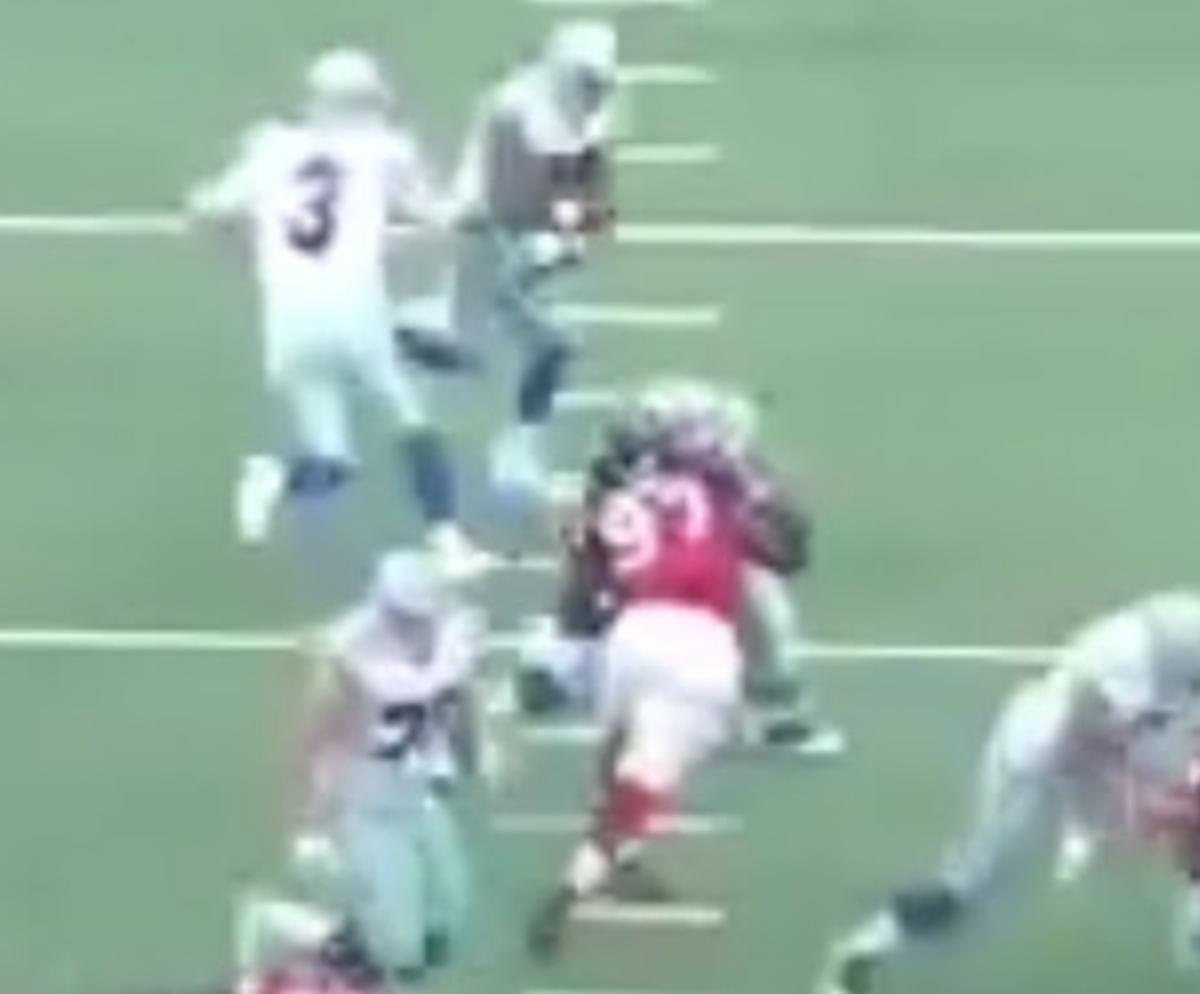
By his third step, Frederick has his hips and body in position to seal off this defender. The seal is huge on this play allowing the halfback to hit the play on the front side rather than having to bend it back.
The other side of this is that the running back should help set up the defense as well. A proper setup gives the offensive line a larger margin for error on a play and makes their job easier. The running back should almost always take at least 5 steps towards the intended hole (TE or ghost TE) before cutting even if he gets an obvious read. This will force the defenders to not cheat their blocks to close the open hole. After the running back takes his five steps (also known as pressing the hole), he should make one cut and go. While the offensive line defines the read, the running back is in charge of setting everything up so that it works.
Another clip of Joe Mixon running wide zone to the open side pic.twitter.com/qwAL1KU3ym
— mike (@bengals_sans) August 5, 2021
Here is one of the best setup running backs in the league, Joe Mixon, setting up his blocks to help out his offensive line.
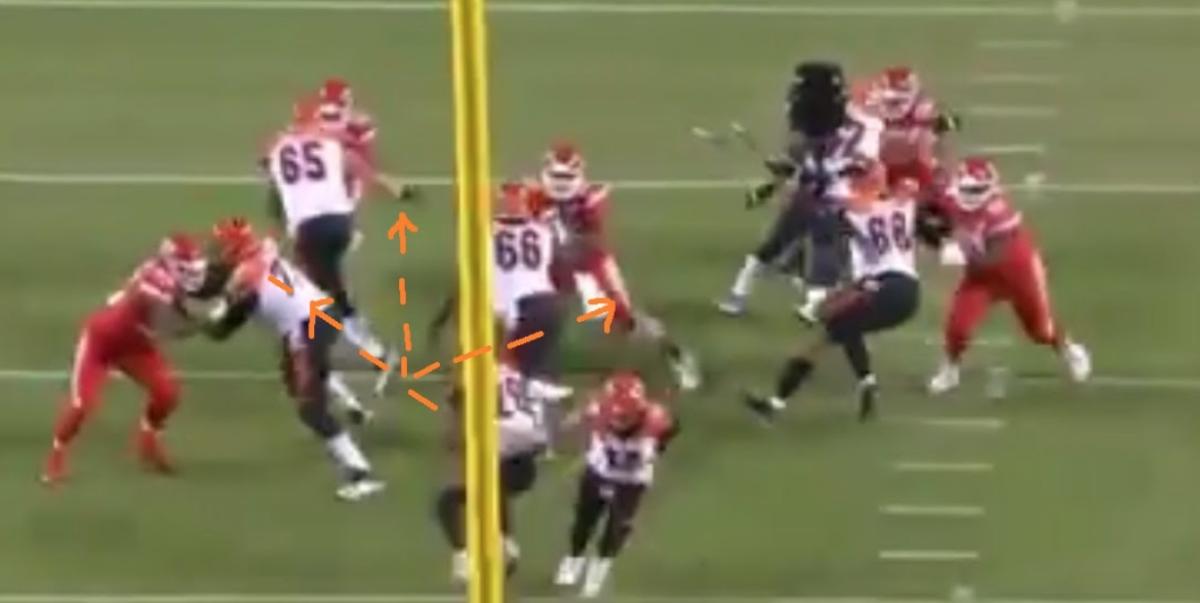
From this point, Mixon has three options, and to better set himself up for success he will press the hole to make the defense commit.
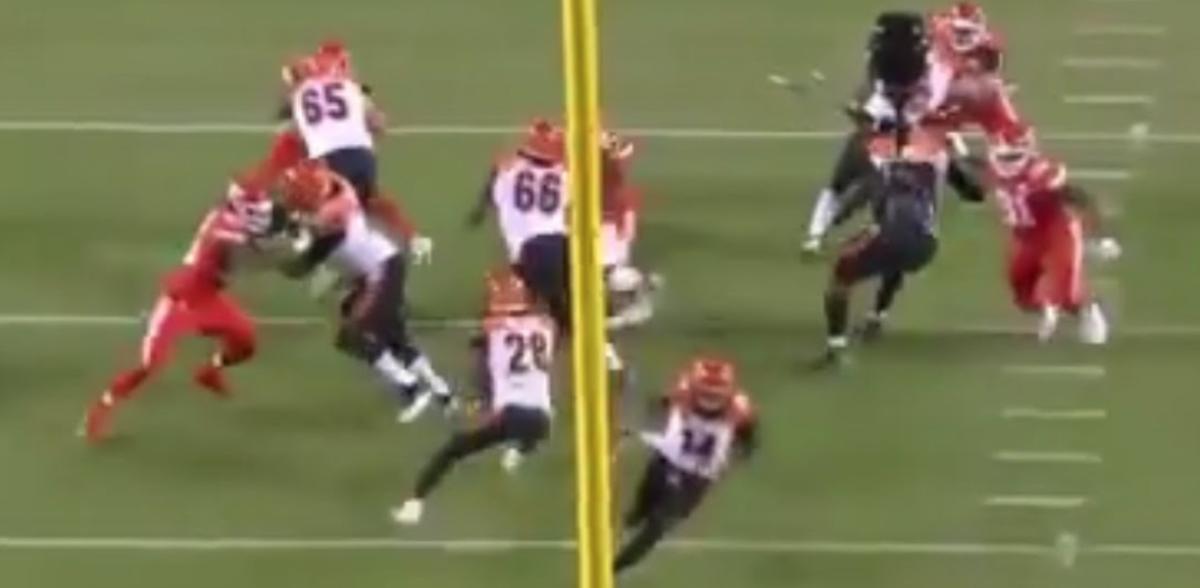
He takes a large step to the outside to make the defenders commit to the playside and then uses that foot to push off and jump cut inside.
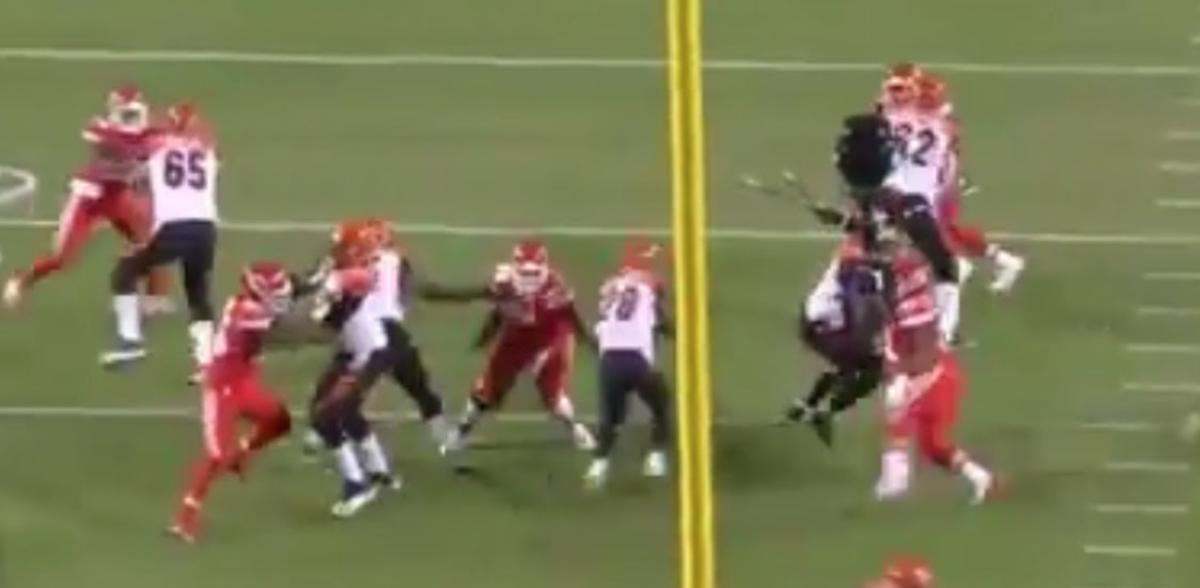
Because Mixon forced the defender to commit to the playside, the defender cannot get back and make the play when Mixon jumpcuts to his backside. Even though this block is not all that effective, Mixon does a good job of playing with the defender’s momentum so that he is still able to get around him for a huge gain.
Pollack wants his wide zone blocking to define the read for the running back which allows the HB to play fast with no guessing. This allows Mixon to set up his blocks better since he will know quickly where he wants to go on the play. While the written description is nice, let’s dive into some more film to get some visuals to go with it.
First run play I watched of Frank Pollack's Raiders team was wide zone to the TE side. Huge gain and a TD. pic.twitter.com/nICDUr8fum
— mike (@bengals_sans) July 31, 2021
This is wide zone to the tight end side, so the running back is going to run at the butt of the tight end to start the play. The entire offensive line takes a step to move laterally and by their second step, they begin displacing/moving the defense horizontally to the play side.
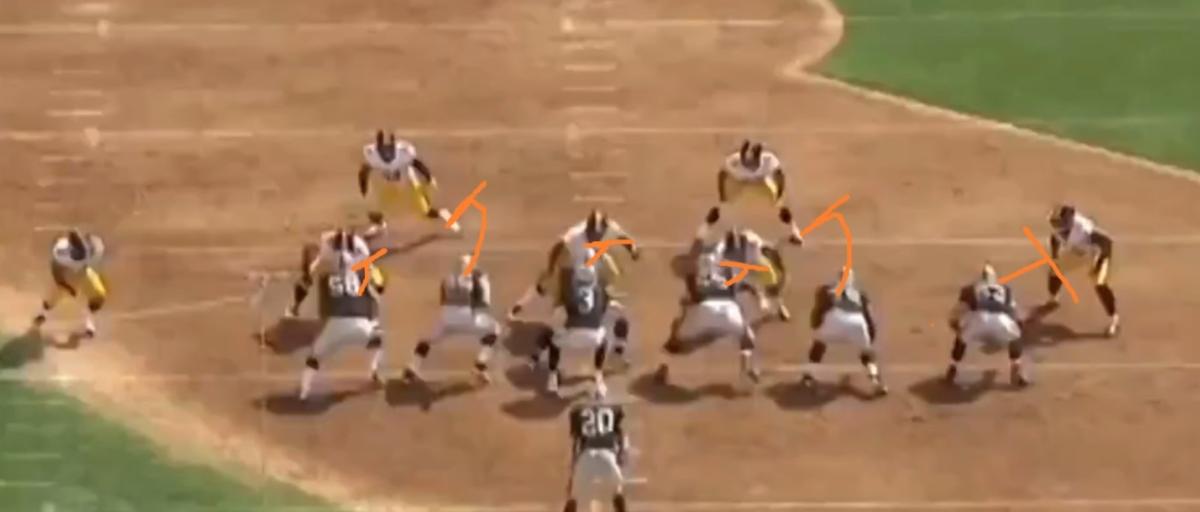
The end man on the defensive line (EMOL) is the first read for the running back on wide zone. If he crashes, the halfback can bounce the run to the outside, but if he sets a hard edge and plays the outside half of his man, the halfback will read the defensive line one gap at a time towards the inside.
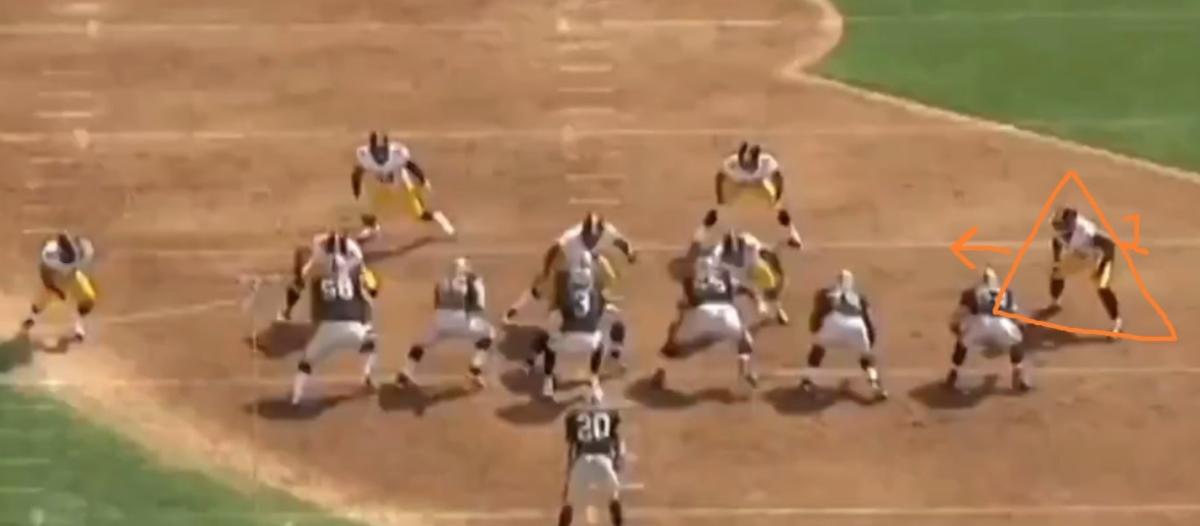
On this play, the EMOL sets a hard edge and forces the run to the inside. McFadden reads one player at a time until he gets a bend read to the backside of the center where there is an opening. He bursts through the hole and then puts a nice move on the safety for a touchdown.
Here is a clip of wide zone from the 2015 Cowboys when Frank Pollack took over. pic.twitter.com/ppKMiNf8cb
— mike (@bengals_sans) August 3, 2021
This is a similar play except instead of the halfback getting a “bend” read like on the last play, he gets a “bang” read to continue down the intended path of the run play. The hole is blasted wide open by Pollack’s offensive line and McFadden takes advantage of that with a huge run play.
More 2015 Cowboys wide zone. This team from the offset I with a FB leading the way. pic.twitter.com/NvBsvC6UNg
— mike (@bengals_sans) August 3, 2021
There are a few differences with this instance of wide zone. The first is that it is a lead wide zone with the full back leading the way rather than wide zone from a singleback formation. The second difference is that there is not a tight end on the playside of this play. This means that the halfback will run towards the “ghost” tight end, which just means that the back will run to where the tight end would be on the play. The last difference is that the defense gives a “bounce” read. The EMOL crashes inside and spills/wrong arms the fullback. Because of this, the running back will bounce the play to the outside.
You can see all three different reads that the defense can give the halfback on wide zone. Bend, bam, and bounce which roughly translate to work backside, hit the intended hole, and get outside respectively. Those three plays also show that Pollack will run his wide zone from multiple formations and personnel groupings. None of those plays are from the same formation or personnel grouping and yet they are all very effective. This is why Pollack and coaches around the league love the wide zone play. It is one of the most versatile run plays in football.
So what can we expect from Pollack’s wide zone system this year? I think the first thing is that there will be an increase in under-center usage for Joe Burrow. This is because neither Pollack nor offensive coordinator Brian Callahan believe in running wide zone from shotgun. The other thing I would expect is for Mixon’s best year running the ball since 2018 when he led the AFC in rushing yards.
I think Pollack’s wide zone does a great job of utilizing Mixon to the best of his abilities. It allows him to make his read and then set it up rather than spending his time behind the line of scrimmage trying to guess where the open hole is. I’ve already shown him doing a fantastic job of pressing the hole and jump cutting off the defender’s momentum, but here is another way Mixon will help elevate the Bengals projected wide zone system.
Joe Mixon bending wide zone all the way back for a nice gain pic.twitter.com/2Lhmyyl5kR
— mike (@bengals_sans) August 5, 2021
This play shows what I mean about Mixon being at his best in wide zone. It gives him an easy read so that he can utilize his impressive abilities. Here the center gets pushed back into Mixon, so he bends the play back and goes all the way back to the outside. This is not normal for a running back to be able to do on wide zone. He has the vision, burst, and reaction ability to turn a dud of a play into a huge gain. If Mixon can properly mix together his ability to set up blocks and work wide zone properly while also mixing in his rare ability to make something out of nothing we could be looking at another year where he runs for 5 yards per carry and is a pro bowl level player.
Like any play, there are ways in which a defense can sell out to stop wide zone. Famously it happened in Super Bowl LIII between Sean McVay's Rams and Bill Belichick's Patriots. Like any good pass rusher or boxer, the offense needs a counter to the defense doing this.
For Film Friday next week, we will dive into some of the counters that an offense needs to carry in order to defeat the defense trying to stop the wide zone play.
Make sure you bookmark AllBengals for the latest training camp news, including exclusive interviews, highlights and so much more!
You May Also Like:
The Bengals Don't Seem Worried About Their Lack of Depth at Offensive Tackle
Watch: Highlights From Wednesday's Practice Include Battle in the Trenches
Vonn Bell Praises Bengals' Defense, Likes What He's Seen From Ja'Marr Chase
Watch: Joe Burrow Connects With Ja'Marr Chase Deep Downfield
Mike Hilton Offers Up Big-Time Praise for Jessie Bates
Camp Notes: Joe Burrow and the Offense Continues to Struggle
Watch Practice Highlights of Jessie Bates, Ja'Marr Chase and More
Trae Waynes, Fred Johnson Dealing With Injuries
Ja'Marr Chase Impressing Coaches and Teammates With His Football Intelligence
Bengals Legend: Joe Burrow is "Better Than I Ever Was"
A.J. Green Off to an Impressive Start for the Arizona Cardinals
Watch: Video Breakdown from Bengals Training Camp
Watch Highlights from Day 4 of Bengals Training Camp
Veteran Offensive Linemen Have Early Training Camp Lead in Battle for Starting Job
Watch Highlights from Day 3 of Bengals Training Camp
Film Breakdown: Why Ja'Marr Chase Has a Chance to be Special
Jessie Bates "Super Eager" to Agree to Contract Extension With Bengals
Joe Burrow Wants to Play in Preseason Games
Zero Dark Thirty: Joe Burrow Exits Social Media For Duration of Training Camp
Day One: Three Observations From Bengals Training Camp Practice
Will Jackson Carman Start For the Bengals in Week 1?
The Bengals Should Be Interested in Disgruntled Cornerback Xavien Howard
Mike Brown Bullish on O-Line: They're Going to "Surprise People"
A Breakdown of the Bengals Toughest Games on the 2021 Schedule
Three Down Look: Bengals Defense Under Pressure to Create Pressure
Joe Burrow Fully Cleared, But Don't Expect to See Him in the Preseason
Watch: Ja'Marr Chase Makes Amazing One-Handed Catch
Ken Anderson Has Big-Time Praise for Joe Burrow
Sam Hubbard on Joe Burrow: "Nobody is Working Harder"
DJ Reader, Trey Hopkins and Joe Burrow Get Good News
Joe Burrow Expected to be Ready for First Training Camp Practice
Bengals Extend Cincinnati-native Sam Hubbard Before Training Camp
The Quest to Protect Burrow: Bengals Bringing in Super Bowl Champion Center
Film Breakdown: The Good, the Bad and the Ugly for Left Tackle Jonah Williams
Bengals Bolster O-Line With Former Cardinals Center
Bengals Ring of Honor Revealed: The Two Ken's Join the Inaugural Class
Here are the Important Preseason and Training Camp Dates You Need to Know
Bengals Pass Blocking Expected to be Much Improved This Season
The Good, the Bad and the Ugly From Vonn Bell's First Season in Stripes
Mike Brown Praises NFL Legend: 'The Greatest QB I Ever Saw Play'
Former NFL Scout Believes Chase and Burrow Will Have Huge Season
Film Breakdown: DJ Reader Should Be an Impact Player for the Bengals
Join the Faces of Who Dey Nation for Thursday Night Football
-----
Be sure to keep it locked on AllBengals all the time!
Subscribe to the AllBengals YouTube channel
Follow AllBengals on Twitter: @AllBengals
